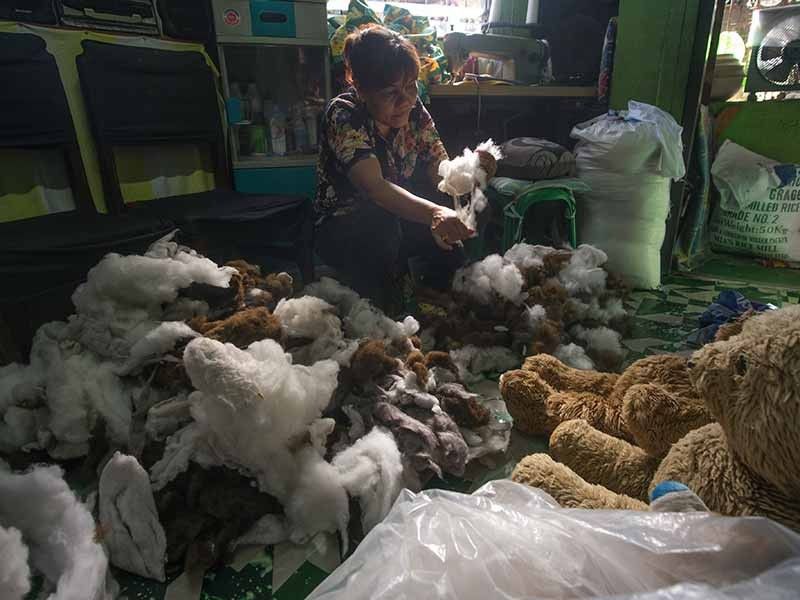From plastic waste to plushies: Payatas residents survive by recycling

MANILA, Philippines — Every day, colorful stuffed toys are hung up to dry along Doris Mutya's street in Payatas, Quezon City.
While the Payatas dumpsite has been closed down since the tragic landslide in 2000 that killed 232 people, many junk shops still operate in the area and residents like Mutya make a living by salvaging junk.
A garbage collector sorts plastic waste at a junk shop in Tondo, Manila.
According to a report by the United Nations Environment Program, the Philippines is the fourth largest generator of solid waste in Southeast Asia, generating 14.66 million tons of waste per year.
The country is also ranked as the third largest contributor of plastic waste to the ocean. Annually, 60 billion sachets are used, most especially by low-income Filipinos, the market of corporations that sell fast-moving consumer goods.
The plastic industry is a driver of climate change and is seen to outpace coal by 2030. Poor countries like the Philippines are among the most vulnerable to disasters brought by the climate crisis.
Most impacted by these are urban poor women like Mutya, who, despite having a smaller carbon footprint, are the victims of natural and man-made disasters through economic displacement and destructive development.
Recycling 'rubbish'
"When people get tired of things, they throw them away, but what they don’t know is that their rubbish still has value," said Mutya.
Mutya has been residing in Payatas since the late 1990s. After working at a junk shop for a year and learning about the different ways people can earn from waste, Mutya developed a greater appreciation for garbage.
Earning slightly better from recycling, her husband quit his job as a security guard and joined her. Now the couple’s main income relies on reworking old stuffed toys.
Mutya buys sacks of disposed stuffed toys from a junkshop in Payatas. She said these were collected by garbage collectors from Tondo and Montalban and are sold at junkshops for recycling. She buys them in bulk to wash and repair and sells them as new.
Outside her home are two washing machines, a dryer, and a tub which she fills with chlorine, liquid soap, and disinfectants. She cuts the stuffed toy, removes its synthetic cotton, and washes the cloth and the fiber separately.
“These are not made of real cotton that’s why they don’t degrade. These are made of synthetic fibers, still made of plastic,” explained Mutya.
Mutya washes the stuffed toys she ordered for the day.
After washing, she hangs both the cloth and the fibers to dry. Once dry, she separates the fibers for stuffing and sews the stuffed toy again.
"Separating the fibers takes a long time because you do it manually... by hand. We do this so the bears wouldn't be bulky and are soft when hugged," she explained.
Mutya puts the synthetic cotton inside a washed stuffed toy.
Nothing is thrown away in Mutya’s home. Her husband Wilson sorts through a pile of collected googly eyes to replace missing parts of other stuffed toys.
Wilson does a minor repair on a toy with holes
Each stuffed toy is blow-dried to ensure it’s good as new.
"We keep all the trash here unless they’re really considered as rejects," said Mutya.
At night, her family sells recycled stuffed toys, thrifted clothes, and pillows along Litex Road.
A mother and daughter purchase a stuffed toy from Mutya
On rare good days, Mutya can earn as much as P2,500 for a whole night of selling. Small toys sell for just P20, but large life-sized stuffed toys can go for as much as P800. On average, she sells toys worth P50-150.
She said she doesn’t earn much, but at least the job can pay some of their bills.
"Our only 'enemies' in this livelihood are typhoons and raids. When it rains, we can't put our products on display. When there are raids, authorities confiscate our products," said Mutya.
Despite having permits from their local organization, authorities may still bar them from selling on the sidewalk. Mutya said that workers can rely on each other because they understand the struggle of making a day-to-day living.
"When there are raids, tricycle drivers inform us so that we could pack our products up and avoid getting penalized unfairly. We learned to adapt by using one large cloth to spread on the floor. So, when raids occur, we just have to pull it up to quickly pack all the toys," explained Mutya.
She also recalled that during lockdowns, sidewalk vendors like her had to look for other sources of living. Some recyclers also shifted jobs because the pandemic limited their sales.
Learning sustainable practices from the poor
Cloth of stuffed toys hang outside Mutya’s home.
For Marian Ledesma, Zero Waste campaigner for Greenpeace, Mutya's livelihood can be considered one of the best examples of recycling since, most of the time, recycling facilities still use virgin plastic materials to convert plastic waste into other materials.
But, in Mutya's case, she just returns the product to what it was before.
"It’s good that communities are finding ways to manage the waste that we have right now, but the danger is, society is relying so much on individuals to come up with the solutions," said Ledesma.
She also emphasized that while Greenpeace encourages recycling, it should not be seen as the sole solution to the current plastic problem. The solution to too much plastic should be a combination of efforts from communities, corporations and the government.
"This is a very clear example that it's the low-income communities, vulnerable communities that find ways to manage this waste. But systemic changes to address the waste problem should come from the government and companies. It's not fair to just expect individuals and communities to be doing all the hard work," added Ledesma.
Jefferson Chua, another campaigner from Greenpeace, said that examples like this prove that there are sustainability practices of the poor that are already being practiced on the ground, but there is little investigation and capacitating to scale these efforts up.
Bobby Bueno dries foam and synthetic cotton in Payatas, Quezon City. The foam comes from factories and he buys them from garbage trucks for a living. Bueno sorts the foam and synthetic cotton, dries them under the sun for days to remove its stench. His customers are the ones responsible for sanitize the foam.
Chua also discussed a different perspective of the poor’s “tingi” (buying in small amounts) culture. The poor, because of limited options, become slaves to sachets because they do not have a lot to spend, but the "tingi" culture also shows the poor's open-handedness because "they only get what they need," he said.
Mutya is not the only one from her community who sells recycled stuffed toys for a living. Once or twice a week, an L300 van drops by her sister-in-law's place to pick up sacks of stuffed toys that are sold online.
She is unsure if the plushies reach department stores, however, she’s certain that some of her customers at night are sales ladies from these retailers.
"They work there, but don’t buy toys there, because they’re more expensive," she said.
Chua said that during typhoons, people usually see photos of depressed areas filled with trash, but it’s not the poor’s fault.
"It is in their communities because 'development' forced it to be there, and that’s essentially a marshaling of space. You can’t see that in affluent areas because they have better systems, and at the end of the day, the poor bear the brunt of that," he said.
Mutya also said that most people may look down at them for making a living out of waste, but she takes pride in the fact that they're not making "dirty" money.
"People who judge us for our livelihood have little understanding of the work that we do. They don’t know that there is value in retrieving waste," she said.
"These stuffed toys, made of non-biodegradable materials, could possibly block drainage systems and cause floods. Even in small ways, I'm glad that we are able to reduce waste and make money out of it, but what makes me really happy is seeing children’s faces light up because of our simple toys," she added.
A little girl strolls around at night with her recycled stuffed cat from Mutya.
--
This story was produced with support from Internews’ Earth Journalism Network and Photojournalists' Center of the Philippines.
Geela Garcia is a freelance multimedia journalist and peasant advocate based in Manila.
- Latest


























